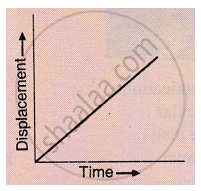Advertisements
Advertisements
प्रश्न
A bus running at a speed of 18 km/h is stopped in 2.5 seconds by applying brakes. Calculate the retardation produced.
उत्तर
We have to find the value of retardation. So,
Initial velocity,
`(u)` = 18 km/hr
= `"18(1000)"/3600` m/s
= 5 m/s
Final velocity, (v) = 0 m/s
Acceleration , `a = (v-u)/t`
Put the values in the above equation to get the value of acceleration
`a = (0-5)/2.5`
= `-2 "m/s"^2`
Thus, the retardation is 2 m/s2.
APPEARS IN
संबंधित प्रश्न
What conclusion can you draw about the velocity of a body from the displacement-time graph shown below :

Name the quantity which is measured by the area occupied under the velocity-time graph.
A motorcycle moving with a speed of 5 m/s is subjected to an acceleration of 0.2 m/s2. Calculate the speed of the motorcycle after 10 seconds, and the distance travelled in this time.
A bus increases its speed from 36 km/h to 72 km/h in 10 seconds. Its acceleration is :
The slope of a speed-time graph gives:
Differentiate between uniform acceleration and variable acceleration.
Write three equations of uniformly accelerated motion relating the initial velocity (u), final velocity (v), time (t), acceleration (a) and displacement (S).
Derive the following equations for uniformly accelerated motion:
(i) v = u + at
(ii) `"S = ut" + 1/2 "at"^2`
(iii) v2 = u2 + 2aS
where the symbols have their usual meanings.
A body is thrown vertically upward with velocity u, the greatest height h to which it will rise is,
Draw a velocity versus time graph of a stone thrown vertically upwards and then coming downwards after attaining the maximum height.
